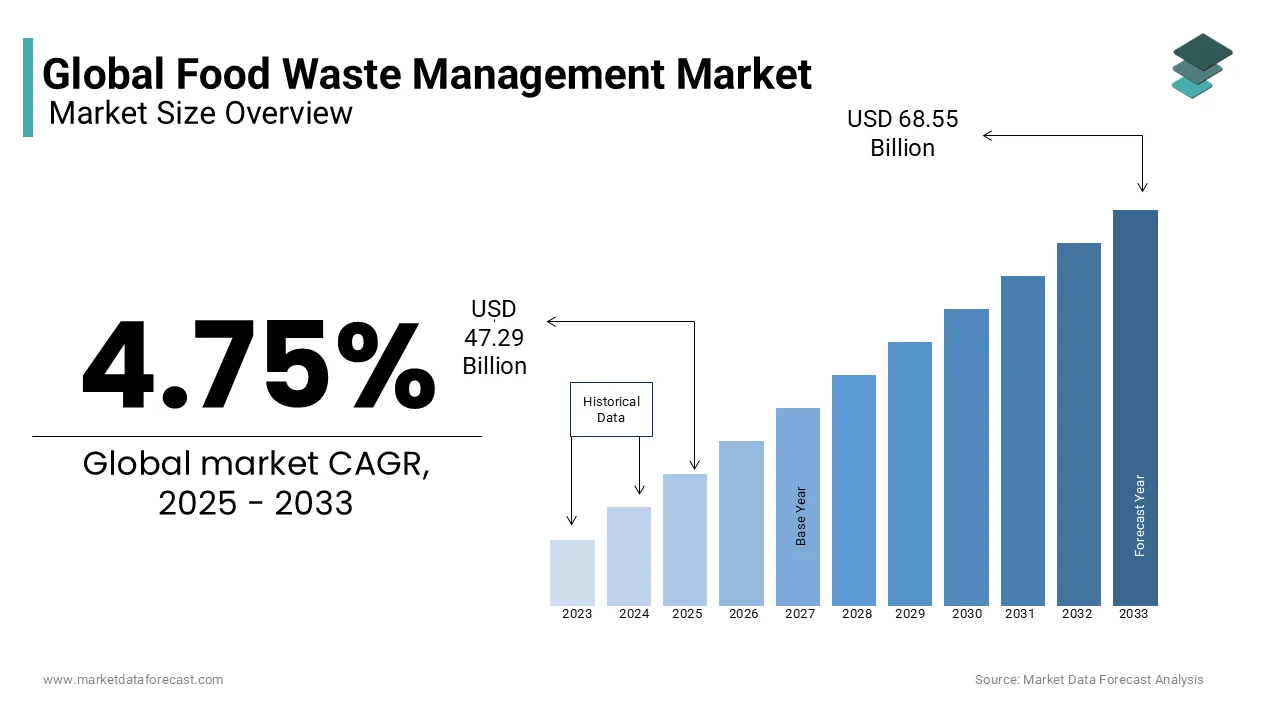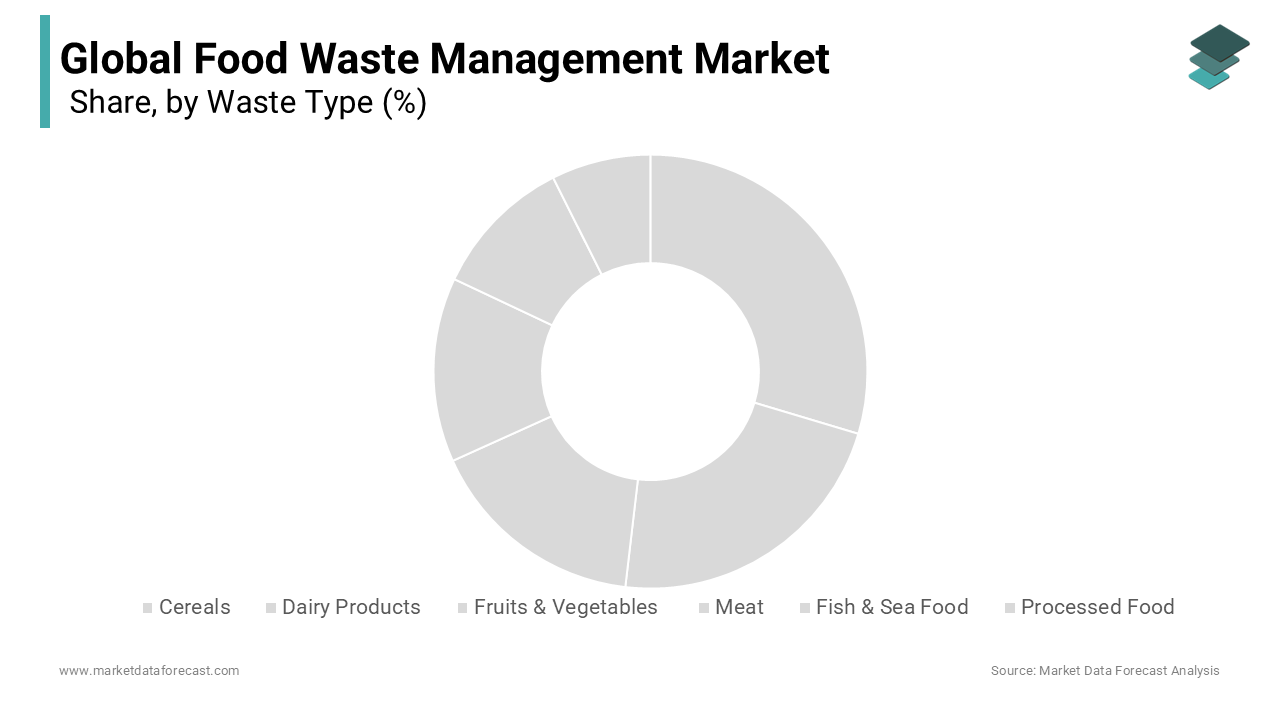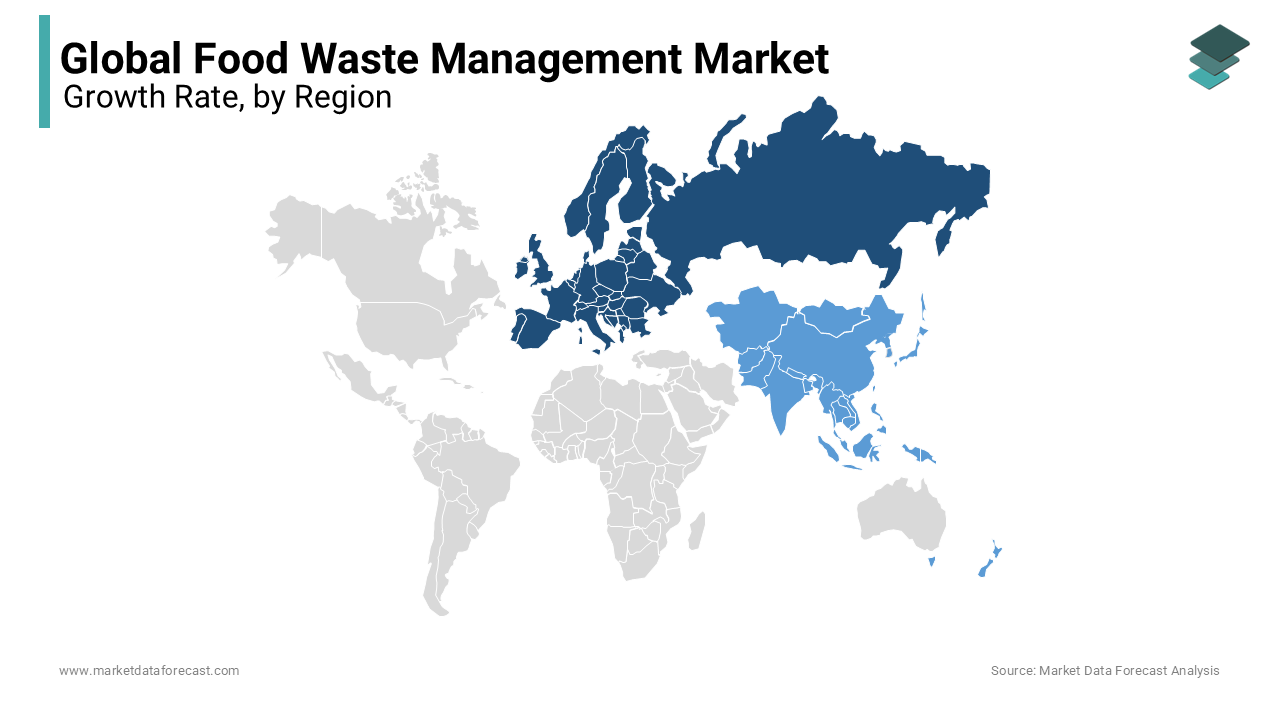Global Food Waste Management Market Size, Share, Trends & Growth Forecast Report - Analysis By Type (Cereals, Dairy Products, Fruits & Vegetables, Meat, Fish & Sea Food, And Processed Food), Process (Aerobic Digestion, Anaerobic Digestion, Combustion/ Incineration, And Others), Application (Animal Feed, Fertilizers, Biofuel, And Power Generation), Source (Primary Food Producers, Food Manufacturers, Food Distributors & Suppliers, Food Service Providers, Municipalities & Households), Method (Prevention, Recovery, Recycling), and Region (North America, Europe, Asia Pacific, Latin America, Middle East And Africa And Rest Of The Region) – Industry Analysis (2025 to 2033)
Global Food Waste Management Market Size
The global market size of food waste management is predicted to be valued at USD 45.15 billion in 2024 and it is expected to reach USD 68.55 billion by 2033 from USD 47.29 billion in 2024, growing at a CAGR of 4.75% from 2024 to 2032.

Current Scenario of the Global Food Waste Management Market
The food waste management market has started to gain traction. Currently, one-third of all food cultivated or prepared worldwide by weight is wasted or lost among farms and forks i.e. over 1 billion tons. When changed into calories, this matches to 24per cent of the world’s food supply results in being not eaten. While 1 in 10 individuals around the world continues to be malnourished. As of now, the market stands in a position where there is a huge scope to expand owing to slow progress in the last few decades. However, the situation of the market started to turn positive after COVID-19 which got some speed in the last few years.
According to a study, on the whole, 40 percent of food made was being dumped. This shows that 7.5 tons of it are abandoned or rejected routinely. Approximately 84.7 percent of the total waste matter registered was thrown within the garbage bins, on the other hand, the leftover was either given to some or poor animals.
MARKET DRIVERS
The growing food waste worldwide on a daily basis, stringent government regulations promoting food waste reduction and increasing awareness about environmental sustainability are propelling the growth of the food waste management market.
The survey, which was conducted by the Food and Agriculture Organization of the United Nations, states that one-third of the food for human consumption, equivalent to 1.3 billion tonnes that were produced in the world, is either lost during supply chain management or wasted intentionally. This wastage of food is a serious issue that needs to get immediate attention, coupled with the number of initiatives started by the governments of various nations with the cooperation of engineering firms as the latter investment in research and development of food waste management machinery is propelling the growth of the global food waste management market.
The growth of the food processing sector is driving the food waste management market.
The rapid growth of the food industry is one of the significant factors for the growth of the global food waste management market owing to the requirement of food waste management systems involved in the rising trend of an increasing number of restaurants, dining out, hotels, quick service restaurant, and other food outlets. Additionally, there is an increase in food waste waste in the food supply chain significantly because of the several systems that are installed, including anaerobic and aerobic digestion processes for food waste recycling. Also, the rising population, high environmental awareness, and rapid industrialization have further fueled the demand for solutions to food waste management, which is affecting the target market positively.
MARKET RESTRAINTS
The growth of the food waste management market is hampered by the huge loss along the value chain and is further worsened by the absence of quantification of wasted food. As per research, it is expected that around 600 billion dollars of food goes to garbage around the world during or right after reap. Most countries do not take the necessary and time to time measures to handle the problem and some even don’t put effort into calculating the amount of damage suffered. This is a major obstacle impeding the growth rate of the market.
MARKET CHALLENGES
Food waste affects every nation on the planet and severely hits climate change. This in the end impacts the overall cost of operating and maintaining the food wastage firm constitutes a significant restraint of the global food waste management market. Moreover, substantial financial support from the government is required because it is a problem of huge magnitude and the assistance is not there or is not even allocated by some public organizations in their annual budgets. Apart from the acquisition costs of equipment and establishing infrastructure, a significant sum of money is required to create awareness among the general public. Another major challenge for market expansion is to curb the discharge of harmful gasses at every stage of the food chain.
MARKET OPPORTUNITIES
The current situation of China and India presents a huge opportunity for the food waste management market. The concept of green vehicle activity utilising green fuel from food wastes in the coming year has been proposed as a potential solution in new research, which if realized will significantly accelerate the market growth. Internal combustion engine vehicles (ICEVs) employing bioethanol and biomethane, biohydrogen for Fuel cell vehicles (FCV), and bioelectricity for plug-in electric vehicles (PEV) have been put forward. Moreover, the four largest food waste producer nations globally i.e. Brazil, the USA, India and China were examined for possible manufacturing of green energy, and the discharge of greenhouse gases (GHG) per green vehicle activity was investigated and compared till 2030. Hence, there is immense potential for market expansion.
REPORT COVERAGE
|
REPORT METRIC |
DETAILS |
|
Market Size Available |
2024 to 2033 |
|
Base Year |
2024 |
|
Forecast Period |
2025 to 2033 |
|
CAGR |
4.75% |
|
Segments Covered |
By Waste Type, Source, Process, Application, Method And Region. |
|
Various Analyses Covered |
Global, Regional and Country Level Analysis; Segment-Level Analysis; DROC; PESTLE Analysis; Porter’s Five Forces Analysis; Competitive Landscape; Analyst Overview of Investment Opportunities |
|
Regions Covered |
North America, Europe, APAC, Latin America, Middle East & Africa |
|
Market Leaders Profiled |
Advanced Disposal Services, Inc., Republic Services, Inc., Waste Management, Inc., Waste Connections, Inc., Stericycle, Inc., Clean Harbors, Inc., FCC Environment Ltd, Veolia Environnement SA, CT Environmental Group Ltd, Recology Inc. |
SEGMENTAL ANALYSIS
Global Food Waste Management Market Analysis By Waste Type
The fruits and vegetables segment accounted for the largest share under this category of the food waste management market. Fruits and vegetables are lost or wasted at all the steps of consumption, processing, transportation, storage and production and a huge quantity of food available for human use goes to garbage worldwide. A recent survey estimated that around 8.2 million purchased crates of fruits and vegetables are wasted each year in houses, due to excessive shopping than the actual need. For instance, overall in the United Kingdom, buyers spend 17 billion pounds each year on food which results in going to garbage bags i.e. equal to 1000 pounds for a family of four annually.

Global Food Waste Management Market Analysis By Process
The aerobic digestion segment gained the top spot and is projected to grow further during the forecast period for the food waste management market. It is a lot quicker and cleaner substitute for conventional food waste disposal methods. Moreover, this digester has risen as a common solution for responsibly removing natural waste, ultimately surging the segment’s market share. In addition, the advantage of aerobic digesters is that this device can be utilized to move forward the conversations over the effect of food waste on the surroundings. For instance, a few aerobic digesters, such as the LFC biodigester by Power Knot are capable of tracing the forms and volume of waste broken down.
Global Food Waste Management Market Analysis By Source
The municipalities and the household segment is believed to register a higher CAGR and propel considerably in terms of share over the forecast period. Food waste caused by families is anticipated to rise as the population expands and the way of living changes. Also, extravagant shopping, over-food preparation, unsuitable food management, an absence of cooking abilities, and inappropriate storage are all elements that add up to food wastage in houses.
Global Food Waste Management Market Analysis By Application
The animal feed segment is likely commanded under this category of the food waste management market. As other types of food waste usage are more costly, the expense of utilising garbage in animal feed is majorly higher, which is driving the segment’s market growth. According to a survey, 30 per cent of what is given to livestock across the world presently is either waste from the supply networks or by-products from producing and processing food. In the United States, around 10 per cent of excessive food is already in the process of transferring to feed animals, the majority originates from production facilities or grocery shops.
Global Food Waste Management Market Analysis By Method
The prevention segment is expected to gain more traction over the forecast period for the food waste market. Considering the current condition of food security and pollution levels, in the coming years, the government and other agencies will more aggressively enforce the laws and regulations on food loss or waste. Moreover, decreasing consumer food loss by just 20 per cent to 25 per cent by 2030 even can save approximately 120 to 300 billion dollars each year worldwide.
REGIONAL ANALYSIS
Europe is the region that has acquired a share of close to one-third of the food waste management market.The factors contributing to the regional growth include government initiatives for reducing food wastage along with the rising investment in advanced disposable techniques to acquire useful products like biogas and fertilizers, which are the growth factors of the target market in Europe.

Asia Pacific provides great potential for the food waste management market.
This can be due to the critical levels of food loss and waste (FLW) in the entire region which adds up to malnutrition and food insecurity, discharge of greenhouse gases, ecological pollution, etc. Moreover, China demonstrated a concerning escalation in FLW and is in the top 10 nations worldwide, based on FLW and related GHG emissions, contributing to pollution. Additionally, food waste management in India continues to be mainly a linear system of gathering and dumping which has a devastating role in health and ecological hazards. According to a study, urban India is going to encounter a huge food waste removal issue if this linear system is not transformed or altered into a circular type. Also, it is evident from the ongoing pattern that there remains much more to do to attain the international criteria for food garbage disposal from the viewpoint of a circular economy. Hence, there is an immediate need for food waste management in the country, ultimately presenting opportunities for domestic and international players.
KEY PLAYERS IN THE GLOBAL FOOD WASTE MANAGEMENT MARKET
Companies playing a key role in the global food waste management market include Advanced Disposal Services, Inc., Republic Services, Inc., Waste Management, Inc., Waste Connections, Inc., Stericycle, Inc., Clean Harbors, Inc., FCC Environment Ltd, Veolia Environnement SA, CT Environmental Group Ltd, Recology Inc.
RECENT HAPPENINGS IN THE MARKET
- In August 2024, Therm Solutions, Inc. reported the introduction of the food loss diversion carbon credit project. It is a first-of-its-kind project and is aiming the grocery stores to lower food waste at the origin. This unique initiative will redirect the safe-to-eat food which is planned for the landfill from over 1300 grocery shops and 18 food supply places covering seven U.S. states to donation centres, solving the country’s immediate weather and food availability crises.
DETAILED SEGMENTATION OF THE GLOBAL FOOD WASTE MANAGEMENT MARKET INCLUDED IN THIS REPORT
This research report on the food waste management market has been segmented and sub-segmented based on waste type, source, process, application, method and region.
By Waste Type
- Cereals
- Dairy Products
- Fruits & Vegetables
- Meat
- Fish & Sea Food
- Processed Food
By Process
- Aerobic Digestion
- Anaerobic Digestion
- Combustion/Incineration
- Others
By Application
- Animal Feed
- Fertilizers
- Biofuel
- Power Generation
By Source
- Primary Food Producers
- Food Manufacturers
- Food Distributors & Suppliers
- Food Service Providers
- Municipalities & Households
By Method
- Prevention
- Recovery
- Recycling
- Others
By Region
- North America
- Asia Pacific
- Europe
- Latin America
- Middle East and Africa
Frequently Asked Questions
1.What are the main sources of food waste, and how much food is wasted globally?
Agricultural production: Harvest losses, surplus crops, and imperfect or unsellable produce.
Food processing and manufacturing: Surplus or damaged products, trimmings, and by-products.
Distribution and retail: Excess inventory, unsold products, expired goods, and damaged or imperfect items.
2.What are the challenges facing the food waste management market?
Lack of infrastructure: Insufficient collection, processing, and recycling infrastructure for organic waste management, especially in developing countries and rural areas with limited resources and technology access.
Regulatory barriers: Complex regulations, permitting requirements, and waste management policies that vary by jurisdiction, hindering the implementation of food waste reduction and recovery initiatives.
3.What are the benefits of effective food waste management?
Environmental sustainability: Reducing methane emissions from landfills, conserving natural resources, minimizing habitat destruction, and mitigating climate change impacts associated with food waste.
Resource conservation: Recovering valuable nutrients, energy, and materials from organic waste streams for reuse, recycling, or energy recovery, promoting circular economy principles and resource efficiency.
Related Reports
Access the study in MULTIPLE FORMATS
Purchase options starting from
$ 2500
Didn’t find what you’re looking for?
TALK TO OUR ANALYST TEAM
Need something within your budget?
NO WORRIES! WE GOT YOU COVERED!
Call us on: +1 888 702 9696 (U.S Toll Free)
Write to us: sales@marketdataforecast.com